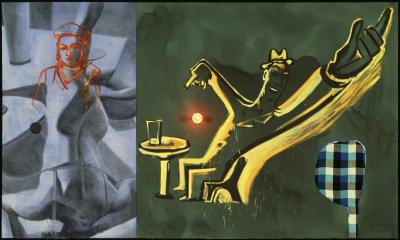Parrish Presents Three Who Bucked the Trend

It seems silly in retrospect, but there was once a time when painting was so out of favor in the art world that artists who chose it as a medium were considered doomed to irrelevancy.
Back in the late 1970s and early ’80s, three of the first graduates of the now venerable California Institute of the Arts in Valencia met up again in New York. Ross Bleckner, Eric Fischl, and David Salle all committed early to bucking the trend away from painting in graduate school, where everyone else was dedicated to installation art, photography, and video. In the city and still determined to pursue their medium, they found their contemporaries devoted to conceptual art and new media. Their single-mindedness allowed them to contribute to a revolution that contributed to the definition of 1980s art.
The Parrish Art Museum will capture this moment in their development in “Unfinished Business: Paintings from the 1970s and 1980s by Ross Bleckner, Eric Fischl, and David Salle,” which will open on Sunday. Brought together by David Pagel, an adjunct curator of the museum, the exhibition is the first to focus on the early work of these painters.
The show includes 41 paintings and works on paper from 1976 to 1987 that trace the development of each artist’s mature style. Conceptual in their own way, they each used painting to address social content and comment on contemporary culture and traditional societal norms, be it on the advent of AIDS, the creepy underbelly of suburbia, or the subtext of images found in magazines.
Mr. Pagel has said that “Bleckner, Fischl, and Salle found in paint a medium they could turn to their own purposes. How they interpreted the use of materials and the conventions of painting make their work as relevant today as when it was made.”
They came together in the city at a time when the Mudd Club was a center for arts and music. Mr. Bleckner and Julian Schnabel lived in the same loft building at White Street in TriBeCa.
Mary Boone, a prominent New York dealer, was important in launching the careers of the artists. Mr. Bleckner, who is still represented by the dealer, was first to join the gallery in 1979. He introduced Mr. Salle to Ms. Boone in 1981, and Mr. Fischl in 1982. The dealer saw in these young artists a resurgence of painting and brought them to prominence.
All three also shared a creative haven on the South Fork, and each has maintained a presence here in different hamlets and villages since 1985. Through their decades-long friendship, the exhibition attempts to chart how each artist may have influenced the other.
The show’s catalog includes an essay by Mr. Pagel and an interview with the three artists, who will all be on hand for a book signing on Aug. 19. The exhibition will remain on view through Oct. 16.
